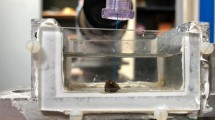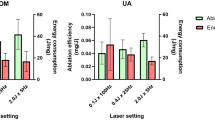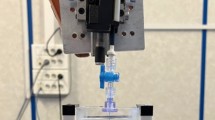Abstract
The primary aim of the present in vitro study is to analyze the chemical content of the bubbles occurring during the fragmentation of cystine stones with both the high-power and low-power holmium:YAG (Ho:YAG) lasers. The secondary aim is to discuss their clinical importance. Three types of human renal calculi calcium oxalate monohydrate (COM), cystine, and uric acid were fragmented with both low-power and high-power Ho:YAG lasers in separate experimental setups at room temperature, during which time it was observed whether gas was produced. After laser lithotripsy, a cloudy white gas was obtained, after the fragmentation of cystine stones only. A qualitative gas content analysis was performed with a gas chromatography–mass spectrometry (GC–MS) device. The fragments in the aqueous cystine calculi setup were dried and taken to the laboratory to be examined by scanning electron microscopy with energy dispersive X-ray spectroscopy (SEM–EDX) and X-ray diffraction analysis. No gas production was observed after fragmentation in the COM and uric acid stones. Free cystine, sulfur, thiophene, and hydrogen sulfide gas were produced by both low-power and high-power Ho:YAG laser lithotripsy of the cystine stones. In the SEM–EDX mapping analysis, a free cystine molecule containing 42.8% sulfur (S), 21% oxygen (O), 14.9% carbon (C), and 21% nitrogen (N) atoms was detected in the cystine stone experimental setup. The evidence obtained, which shows that hydrogen sulfide emerges in the gaseous environment during Ho:YAG laser fragmentation of cystine stones, indicates that caution is required to prevent the risk of in vivo production and toxicity.




Similar content being viewed by others
Data availability
The authors confirm that the data supporting the findings of this study are available within the article [and/or] its supplementary materials.
References
Sumorok N, Goldfarb DS (2013) Update on cystinuria. Curr Opin Nephrol Hypertens 22(4):427–431
Servais A et al (2021) Cystinuria: clinical practice recommendation. Kidney Int 99:48–58
Moore SL, Somani BK, Cook P (2019) Journey of a cystinuric patient with a long-term follow-up from a medical stone clinic: necessity to be SaFER (stone and fragments entirely removed). Urolithiasis 47(2):165–170
Barreto L et al (2018) Medical and surgical interventions for the treatment of urinary stones in children. Cochrane Database Syst Rev. https://doi.org/10.1002/14651858.CD010784.pub2
Ruggera L et al (2011) Retrograde transureteral approach: a safe and efficient treatment for recurrent cystine renal stones. Urol Res 39(5):411–415
Pierre S, Preminger GM (2007) Holmium laser for stone management. World J Urol 25(3):235–239
Becker B, Gross AJ, Netsch C (2019) Ho: YaG laser lithotripsy: recent innovations. Curr Opin Urol 29(2):103–107
Chen J et al (2022) Cavitation plays a vital role in stone dusting during short pulse holmium:YAG laser lithotripsy. J Endourol 36(5):674–683
Chan KF et al (1999) Holmium:YAG laser lithotripsy: a dominant photothermal ablative mechanism with chemical decomposition of urinary calculi. Lasers Surg Med 25(1):22–37
Teichman JM et al (1998) Holmium:YAG lithotripsy: photothermal mechanism converts uric acid calculi to cyanide. J Urol 160(2):320–324
Huzar TF, George T, Cross JM (2013) Carbon monoxide and cyanide toxicity: etiology, pathophysiology and treatment in inhalation injury. Expert Rev Respir Med 7(2):159–170
Graham J and Traylor J (2023) Cyanide toxicity. In: StatPearls. StatPearls Publishing Copyright © 2023, StatPearls Publishing LLC.: Treasure Island (FL)
Dushinski JW, Lingeman JE (1998) High-speed photographic evaluation of holmium laser. J Endourol 12(2):177–181
Rink K, Delacrétaz G, Salathé RP (1995) Fragmentation process of current laser lithotriptors. Lasers Surg Med 16(2):134–146
Thomas S et al (1988) The pulsed dye laser versus the Q-switched Nd:YAG laser in laser-induced shock-wave lithotripsy. Lasers Surg Med 8(4):363–370
Adams DH (1997) Holmium:YAG laser and pulsed dye laser: a cost comparison. Lasers Surg Med 21(1):29–31
Leijte JA, Oddens JR, Lock TM (2008) Holmium laser lithotripsy for ureteral calculi: predictive factors for complications and success. J Endourol 22(2):257–260
Chan KF et al (2001) A perspective on laser lithotripsy: the fragmentation processes. J Endourol 15(3):257–273
Jacques SL (1992) Laser-tissue interactions. Photochemical, photothermal, and photomechanical. Surg Clin North Am 72(3):531–558
Schafer SA et al (1994) Mechanisms of biliary stone fragmentation using the Ho:YAG laser. IEEE Trans Biomed Eng 41(3):276–283
Vassar GJ et al (1999) Holmium:YAG lithotripsy: photothermal mechanism. J Endourol 13(3):181–190
Glickman R et al (2000) Further characterization of photothermal breakdown products of uric acid stones following Holmium:YAG laser lithotripsy. In: Proceedings of SPIE—The International Society for Optical Engineering. 3914
Corbin NS et al (2000) Laser lithotripsy and cyanide. J Endourol 14(2):169–173
Kaygısız O et al (2018) Renal stone composition does not affect the outcome of percutaneous nephrolithotomy in children. World J Urol 36(11):1863–1869
Tiryaki T, Azili MN, Özmert S (2013) Ureteroscopy for treatment of ureteral stones in children: factors influencing the outcome. Urology 81(5):1047–1051
Dilek N et al (2020) Hydrogen sulfide: an endogenous regulator of the immune system. Pharmacol Res 161:105119
Panthi S, Manandhar S, Gautam K (2018) Hydrogen sulfide, nitric oxide, and neurodegenerative disorders. Transl Neurodegener 7:3
Wu DD et al (2019) Hydrogen sulfide as a novel regulatory factor in liver health and disease. Oxid Med Cell Longev 2019:3831713
Guidotti TL (2015) Hydrogen sulfide intoxication. Handb Clin Neurol 131:111–133
Guidotti TL (2010) Hydrogen sulfide: advances in understanding human toxicity. Int J Toxicol 29(6):569–581
Ng PC et al (2019) Hydrogen sulfide toxicity: mechanism of action, clinical presentation, and countermeasure development. J Med Toxicol 15(4):287–294
Ganesamoni R et al (2013) Prospective randomized controlled trial comparing laser lithotripsy with pneumatic lithotripsy in miniperc for renal calculi. J Endourol 27(12):1444–1449
Gauhar V et al (2023) A feasibility study on clinical utility, efficacy and limitations of 2 types of flexible and navigable suction ureteral access sheaths in retrograde intrarenal surgery for renal stones. Urology. https://doi.org/10.1016/j.urology.2023.05.032
De Stefano V et al (2023) Suction in percutaneous nephrolithotripsy: evolution, development, and outcomes from experimental and clinical studies. results from a systematic review. Eur Urol Focus 11:S2405-4569(23)00152-9. https://doi.org/10.1016/j.euf.2023.06.010.
Acknowledgements
The authors thank Selçuk University Advanced Technology Research and Application Center for helping with experimental organization for the study.
Funding
No funding was received for conducting this study.
Author information
Authors and Affiliations
Contributions
Writing—original draft (lead); conceptualization, formal analysis, visualization, resources: MTK; Resources, data curation, methodology: MSÖ; Supervision (lead); Conceptualization, formal analysis, visualization, resources, review and editing: YEG.
Corresponding author
Ethics declarations
Competing interests
The authors declare no competing interests.
Conflict of interest
The authors declare that they have no competing interests exist.
Additional information
Publisher's Note
Springer Nature remains neutral with regard to jurisdictional claims in published maps and institutional affiliations.
Rights and permissions
Springer Nature or its licensor (e.g. a society or other partner) holds exclusive rights to this article under a publishing agreement with the author(s) or other rightsholder(s); author self-archiving of the accepted manuscript version of this article is solely governed by the terms of such publishing agreement and applicable law.
About this article
Cite this article
Kılınç, M.T., Özkent, M.S. & Göger, Y.E. Observation and comparison of gas formation during holmium:YAG laser lithotripsy of cystine, uric acid, and calcium oxalate stones: a chromatographic and electron microscopic analysis. Urolithiasis 52, 23 (2024). https://doi.org/10.1007/s00240-023-01517-4
Received:
Accepted:
Published:
DOI: https://doi.org/10.1007/s00240-023-01517-4




